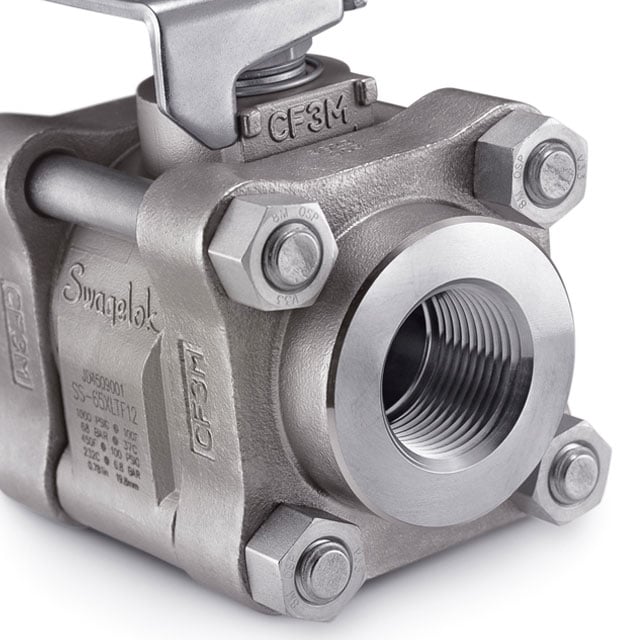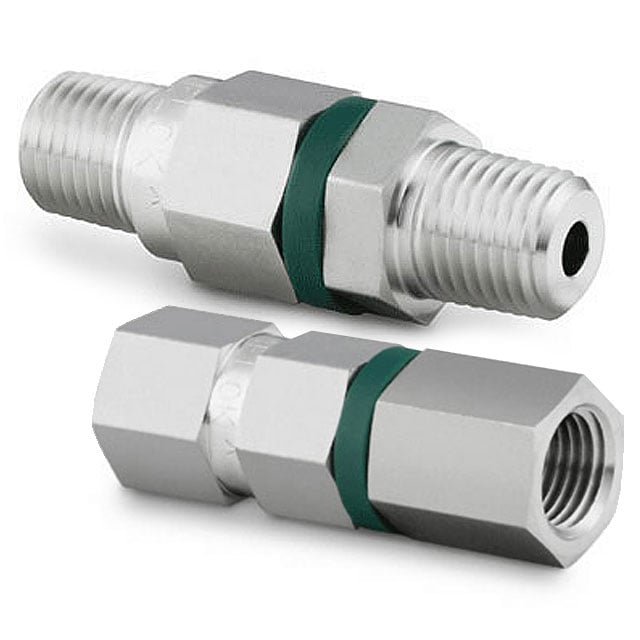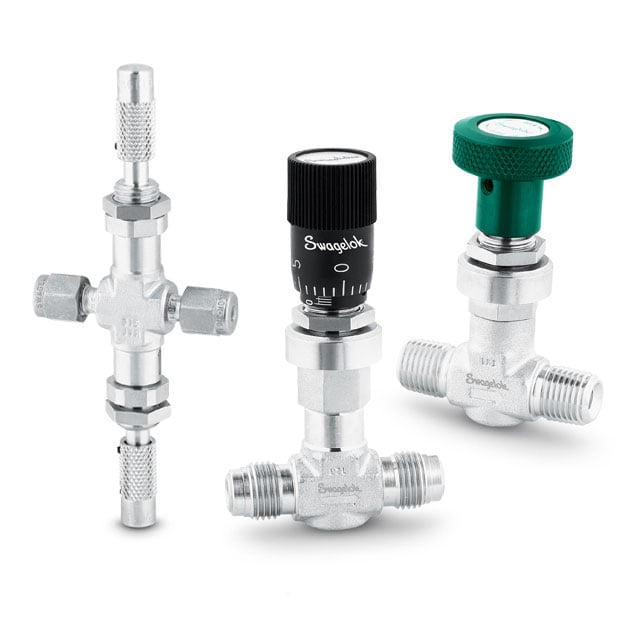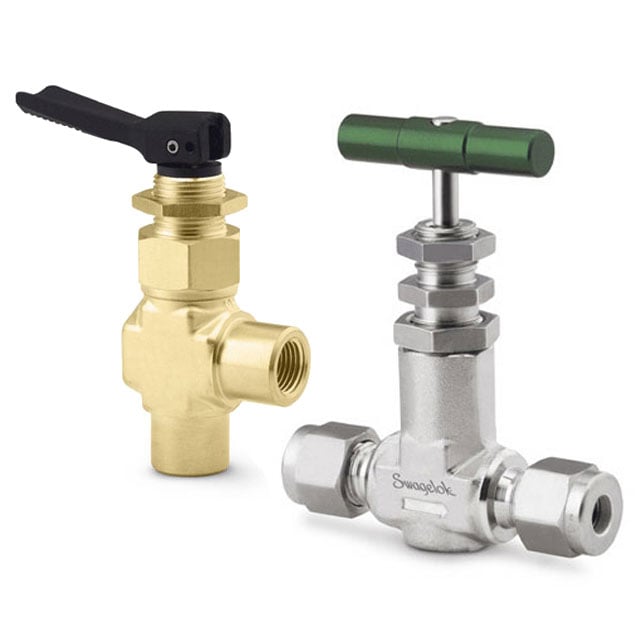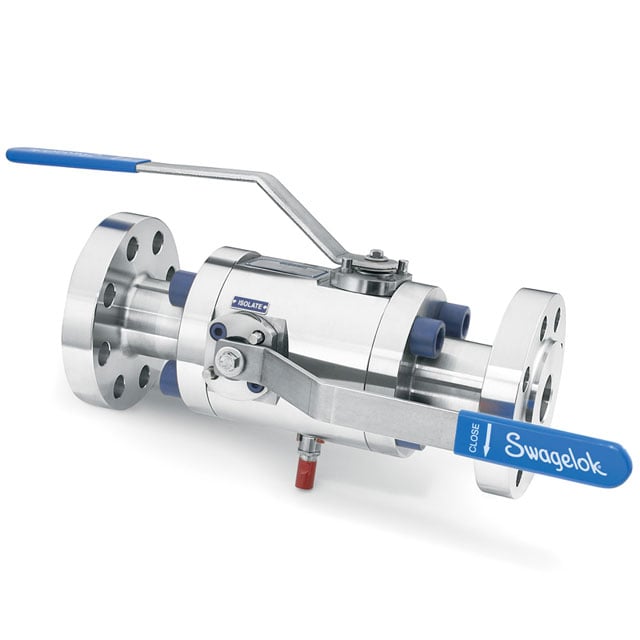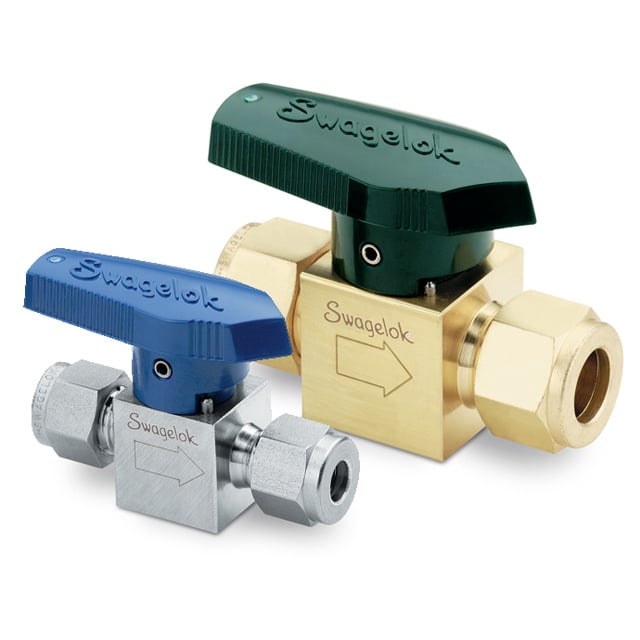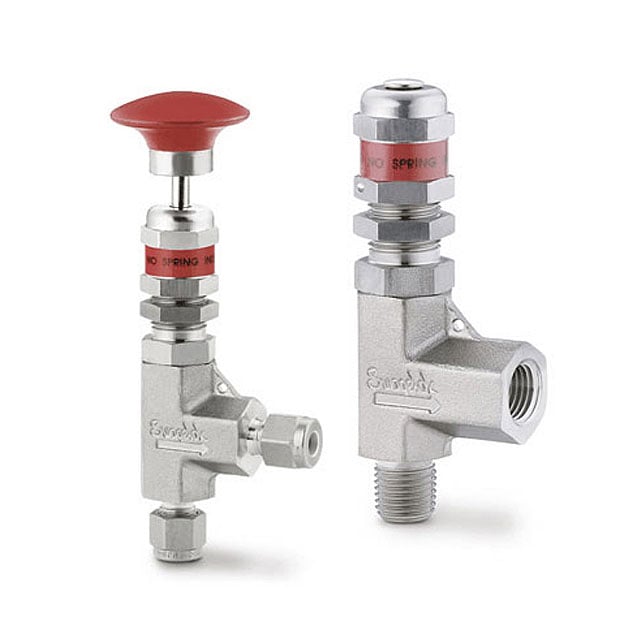Valve Fundamentals
Though they can differ considerably in their mechanisms of action, all valves have the same basic function: to regulate the flow of liquids or gases through a pipe. They may be used to stop or start flow completely, adjust the amount, control the direction, or regulate pressure, and they may function by opening, closing, or obstructing an aperture.
Industrial Valve Applications and Functions
When selecting a valve, the first question to ask is what do you want the valve to do? In refineries, valves have five main functions:
- Starting and stopping flow
- Controlling the rate of flow
- Controlling the direction of flow
- Relieving excess pressure
- Preventing excess flow
There are several different valve mechanisms that perform these functions, and it is important to use the right type for the application. It is not uncommon to see valves used incorrectly—for example, a ball valve used to throttle flow. While a misapplied valve may work adequately in some conditions, it can lead to catastrophic failure in others. In a high-pressure gas system, for example, the sudden burst of gas-enabled by the fast opening of the valve could ignite and start a fire.
In refineries, the three most common valve types by function are isolation valves, control valves, and check valves.
On-Off Valves
The simplest and most common valve function is stopping and restarting flow. These valves are called isolation valves, and they are designed to operate in either the fully on or fully off position. Some types include ball, gate, and diaphragm valves.
On-off valves provide a quick shutoff and high flow capacity. They usually have fairly simple mechanisms, making them less expensive than more complex valve types. Because of their simplicity, reliability, and low cost, they are commonly found throughout all industrial valve applications, including in oil and gas.
Control Valves
Control valves are used to regulate a system’s flow rate, pressure, and temperature by varying the size of the flow passageway. They are usually operated by a hydraulic, pneumatic, or electrical controller for precision. Automatically actuated control valves are essential to regulating the fluid system parameters in any refining operation.
Check Valves
Check valves have mechanisms that allow flow in one direction but not the other. They are often used to protect equipment that could be damaged by backflow and to prevent cross-contamination. They are also used to reduce chatter within pipes.
Types of Valves
While there are only a few different functions that valves fulfill, there are several types of valves with different mechanisms of stopping, starting, and controlling flow. Below are seven of the most common types of valves used in Northern California refineries: ball, butterfly, diaphragm, gate, globe, needle, and plug valves.
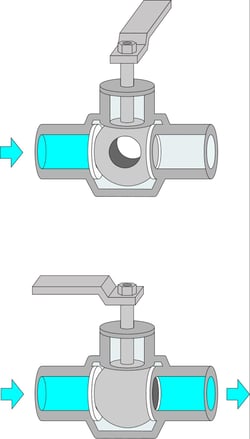 Ball Valves
Ball Valves
Ball valves are the most common of all valve types. They are designed for quick on-off functionality with tight sealing.
A ball valve consists of a metallic ball with a large hole through its center, which is actuated by a quarter-turn handle. When the handle is in the on position, the hole is lined up with the flow path, enabling flow. When turned 90 degrees to the off position, flow is stopped.
Ball valves are best used in the fully open or fully closed positions, as they do not allow precise control over the rate of flow.
Butterfly Valves
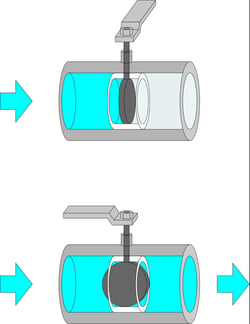
A butterfly valve is another type of on-off valve that uses a disc attached to an actuator to stop and start flow. As with the ball valve, a quarter-turn of the actuator rotates the disc to block flow.
Butterfly valves are lightweight, compact, and simple in construction. They shut tightly, allow easy flow, and can handle high pressure. They are often used as shutoff valves in large-diameter pipes.
Diaphragm Valves
Diaphragm valves have flexible membranes that block flow when actuated. The membrane completely isolates the actuator from the process fluid, making diaphragm valves useful when corrosive fluids could damage metallic parts of the valve. They are usually used for liquid service.
Diaphragm valves’ primary advantage is their ability to seal off the fluid from the rest of the valve, preventing contamination and corrosion. The disadvantage of diaphragm valves is that because of the elastomeric diaphragm, they tend to have a much shorter lifespan than simpler valve designs.
Gate Valves
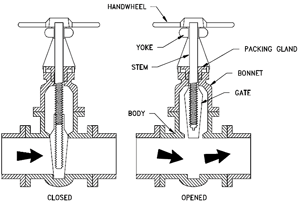
Gate valves are another extremely common on-off valve. A gate valve uses a plate-like barrier that is lowered into the flow stream to stop flow. They are mechanically similar to globe valves, but the gate mechanism creates less flow restriction than a globe valve plug in the fully opened position.
Like other on-off valves, gate valves should be operated in the fully open or fully closed position and not be used for flow control, as the gate can be damaged if left partially open.
Globe Valves
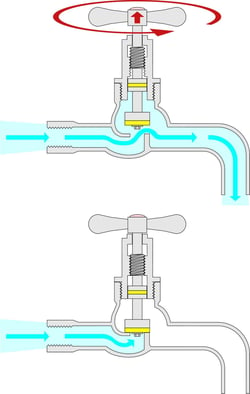 While the above valve types are all meant for on-off operation, globe valves can also be used to regulate the rate of flow. A globe valve contains a plug that is raised and lowered similarly to a gate valve. It can be used to stop and start flow, or it can be partially opened to throttle or adjust flow.
While the above valve types are all meant for on-off operation, globe valves can also be used to regulate the rate of flow. A globe valve contains a plug that is raised and lowered similarly to a gate valve. It can be used to stop and start flow, or it can be partially opened to throttle or adjust flow.
The most common globe valve design is the Z-style valve, which refers to the two 90 degree turns the fluid must make through the valve body. This design means globe valves tend to create more pressure drop than other valve types.
Needle Valves
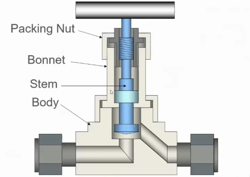 Needle valves contain a small port and a threaded, needle-shaped plunger. The threaded actuation allows very precise regulation of flow; however, the tight design is only capable of relatively low flow rates. Needle valves are used to regulate flow rate when precise control is needed.
Needle valves contain a small port and a threaded, needle-shaped plunger. The threaded actuation allows very precise regulation of flow; however, the tight design is only capable of relatively low flow rates. Needle valves are used to regulate flow rate when precise control is needed.
Needle valves allow precise and reliable flow control. They are most commonly used in flow metering applications, especially when a constant, calibrated, low flow rate must be maintained.
Plug Valves
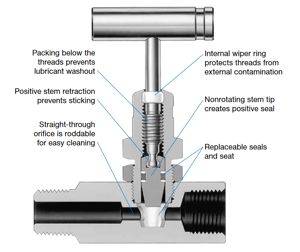 A plug valve constricts flow similarly to a ball valve, but it uses a cylindrical or tapered, ported plug rather than a ported ball to constrict or allow flow. Like a needle valve, it can have a threaded plunger that allows precise control over the flow volume. They can also be quarter-turn valves, which is useful where quick and frequent operation is essential. Plug valves are used for both on-off function and flow control.
A plug valve constricts flow similarly to a ball valve, but it uses a cylindrical or tapered, ported plug rather than a ported ball to constrict or allow flow. Like a needle valve, it can have a threaded plunger that allows precise control over the flow volume. They can also be quarter-turn valves, which is useful where quick and frequent operation is essential. Plug valves are used for both on-off function and flow control.
Plug valves can have multiple ports. The most common type of plug valve has two ports with an open and closed position and is used as an on-off valve.
Plug valves can be either lubricated or non-lubricated. Lubricated plug valves have a lubricant injected between the plug and valve body to act as a sealant, which prevents internal leakage, protects the valve from corrosion, and makes it easier and smoother to operate.
Northern California’s Experts in Industrial Valve Applications
With so many types of valves, it is important to leverage the expertise of an expert in industrial valve applications who can help you choose the optimal valve types for a process based on the functionality desired. Using the right type of valve can improve your system efficiency, reduce maintenance costs, and maximize the lifespans of your valves.
Swagelok has decades of experience engineering and implementing the top valve products in the industry. We’re proud to be a part of helping refineries and petrochemical plants in Northern California, and beyond, improve the reliability of critical components in industrial valve applications. We’ll work closely with you to understand your specific process requirements, and we’ll make sure you get the valves you need to keep your operations running safely and reliably.
To find out more about how Swagelok Northern California can help you with industrial valve applications, contact our team today by calling 510-933-6200.


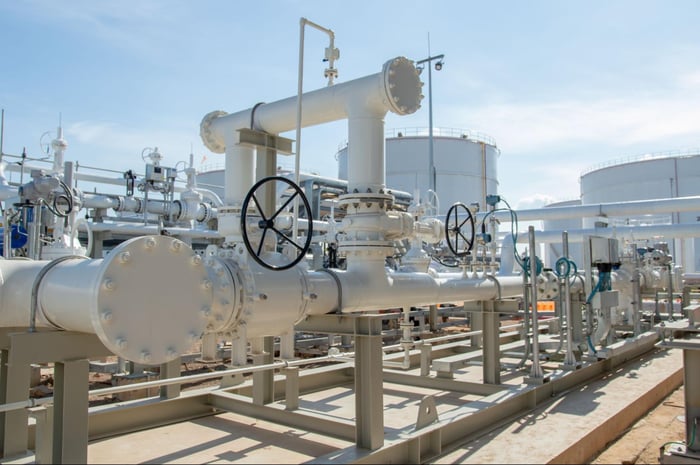
 Ball Valves
Ball Valves
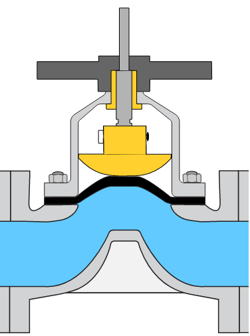
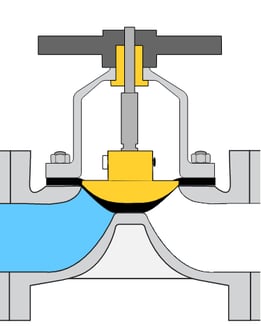

 While the above valve types are all meant for on-off operation, globe valves can also be used to regulate the rate of flow. A globe valve contains a plug that is raised and lowered similarly to a gate valve. It can be used to stop and start flow, or it can be partially opened to throttle or adjust flow.
While the above valve types are all meant for on-off operation, globe valves can also be used to regulate the rate of flow. A globe valve contains a plug that is raised and lowered similarly to a gate valve. It can be used to stop and start flow, or it can be partially opened to throttle or adjust flow. Needle valves contain a small port and a threaded, needle-shaped plunger. The threaded actuation allows very precise regulation of flow; however, the tight design is only capable of relatively low flow rates. Needle valves are used to regulate flow rate when precise control is needed.
Needle valves contain a small port and a threaded, needle-shaped plunger. The threaded actuation allows very precise regulation of flow; however, the tight design is only capable of relatively low flow rates. Needle valves are used to regulate flow rate when precise control is needed. A plug valve constricts flow similarly to a ball valve, but it uses a cylindrical or tapered, ported plug rather than a ported ball to constrict or allow flow. Like a needle valve, it can have a threaded plunger that allows precise control over the flow volume. They can also be quarter-turn valves, which is useful where quick and frequent operation is essential. Plug valves are used for both on-off function and flow control.
A plug valve constricts flow similarly to a ball valve, but it uses a cylindrical or tapered, ported plug rather than a ported ball to constrict or allow flow. Like a needle valve, it can have a threaded plunger that allows precise control over the flow volume. They can also be quarter-turn valves, which is useful where quick and frequent operation is essential. Plug valves are used for both on-off function and flow control.